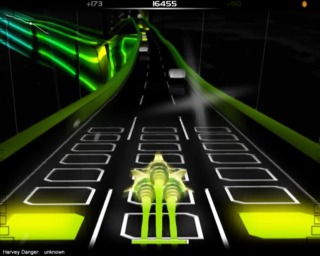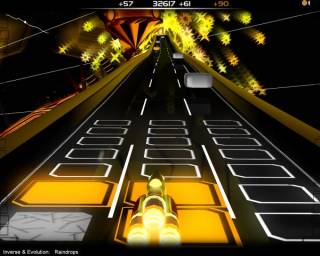Overview
 The highways are almost never fully straight
The highways are almost never fully straightCreated by independent developer Dylan Fitterer and released on Steam on February 15, 2008, Audiosurf is a cross-genre game that combines the block-matching of a puzzle tile with levels that are created from songs like other rhythm-based games. The game allows players to import their own music (a variety of formats are supported, including MP3s, WMAs, and tracks bought from iTunes). A level is generated based on the tempo and intensity of the selected track, and the game highway flows towards you in a manner similar to what you'd expect from the Guitar Hero or Rock Band series. The highway in Audiosurf, though, has similarities to a rollercoaster, and includes rises, falls, twists, and turns. Rises usually indicate slower parts of the song, while drops signify upbeat portions.
Audiosurf was the winner of multiple 2008 IGF awards, and is also the first game to use Valve's Steamworks technology--a freely available development suite that allows developers to integrate Steam's networking code, achievements, and statistic-sharing.
Gameplay
 Three lanes
Three lanesAudiosurf features several different game modes that are determined by the character selection screen, but one thing that all modes have in common is that each song features a highway--of three lanes, most of the time--that contain blocks of various colours. Some modes also have an empty 'shoulder' lane on either side of the highway. As your car travels down the highway, it can occupy and move into either of the lanes. This is done by moving the mouse or pressing left or right on the keyboard, though gamepad-support is included. Rumble is featured with an Xbox 360 controller. By hitting a block, you pick it up and it is placed in the respective column. You score points by combining blocks of the same colour in clusters of three. Certain-colored blocks are worth more points than others (the 'hottest' colours being the most valuable, with red scoring highest, followed by yellow, green, blue, and purple), while creating larger clusters and forming combos are other ways of increasing your score.
 Adding another block to the middle column will cause it to overfill
Adding another block to the middle column will cause it to overfillPlayers are not penalized for avoiding blocks. In fact, selectively avoiding them is key in maximizing your score and preventing overfilling your columns. Overfilling induces a penalty where you are frozen out for a short period of time and cannot pick anything up. Another possible obstacle are gray blocks, which clog up your columns and can potentially interfere with clusters. These blocks will break after a length of time. White and black blocks act in a similar way, but should they end up in the bottom of the grid, bonus points will be awarded.
Some modes also feature power-ups, and they can be picked up just like blocks are. When picked up, they are immediately activated. Power-ups in Audiosurf include coloring each block in the grid to one single color, spawning a few blocks of the same color, sorting the blocks in the grid, and adding a score multiplier.
 The leaderboards
The leaderboardsThe level ends with the song finishes, and any bonuses that you may have received are added on to make the final score. For example, you get a percentage bonus if your grid is empty at the end of the song (known as a 'clean finish'), if you string together a cluster of a sizeable number of blocks, or if you collect a large percentage of yellow or red blocks. Depending on what score you attained, you could be given a gold, silver, or bronze medal. Scores can be posted onto leaderboards, providing you have an Audiosurf account. Each differently tagged song has a casual, pro, and elite leaderboard (where your score belongs depends on the difficulty of the mode that was played), while bits of information such as the track length and form are also uploaded, serving as a way of detecting fraudulent scores, which can in turn be reported.
Game Modes
Audiosurf has many different characters to choose from, each of which belong one of six unique classes. Difficulty tiers are displayed in brackets.
Mono
 Mono: avoid the grays!
Mono: avoid the grays!- Mono (Casual): With no power-ups, the Mono characters are the most basic type, as there are only two colors of blocks present in the highway: colored and gray. While it is straightforward to play and get a decent points total since the puzzle element barely features (the primary objective is to simply avoid all the gray blocks), the main weakness of this class is that its scoring potential may not be as high as the others. This more 'relaxed' class has a 30% 'stealth' bonus if no gray block is hit.
- Mono Pro (Pro): This character has a 'widen' ability that allows it to pick up tiles in all three lanes. It also has the ability to jump over tiles for a few seconds, but costs time to recharge. Highways contain more gray blocks.
- Ninja Mono (Elite): The ninja can widen itself as well as break up any gray tiles that are collected. The latter ability recharges after a few seconds. Highways are even busier than the Pro variant, with more gray blocks to avoid.
Pointman
- Pointman (Casual): The Pointman character can store a tile and drop it into another column. This can be cleverly utilized to form bigger clusters. Holding down the space key brings up 'hint arrows' that suggest which tiles to pick up.
- Pointman Pro (Pro): Pointman Pro plays the same as Pointman but with a more traffic-filled highway. Hint arrows are displayed automatically.
- Pointman Elite (Elite): Pointman Elite is a tougher variant of Pointman Pro but with an even more busy highway.
Double Vision
 Double Vision: four lanes, two cars
Double Vision: four lanes, two cars- Double Vision (Casual): There are two cars to control instead of just one. You can either play by yourself and move both or play cooperatively with another person and control one each. Because of the addition of an extra vehicle, the highway consists of four lanes instead of three. One car can only move in the two leftmost lanes, while the other can only move in the two rightmost.
- Double Vision Pro (Pro): DV Pro plays the same as Double Vision but takes place on a busier highway.
- Double Vision Elite (Elite): DV Elite is the toughest variant of Double Vision with an even more hectic highway than DV Pro.
Eraser
- Eraser (Pro): Holding the left-click or right-click mouse buttons enters eraser mode, which will erase all of a particular color if it hits that tile (for example, if you hit a red block, every red tile in your three columns will be erased).
- Eraser Elite (Elite): Eraser Elite is pretty much the same as Eraser, but the highway is filled with more traffic.
Pusher
- Pusher (Pro): Holding the left-click mouse button as you hit a tile will push it to the left, while holding the right-click will push it to the right.
- Pusher Elite (Elite): Pusher Elite is pretty much the same as Pusher, but the highway is filled with more traffic.
Vegas
- Vegas (Pro): This has a 'shuffle' option, which shuffles the tiles in your columns when you move to either shoulder of the track or by holding down the left-click mouse button. It will also randomly generate a power-up, which can be used by right-clicking.
Ironmode
Ironmode is not an actual game mode but an option. It's an extra layer of difficulty for those who want an even greater challenge. It increases the speed, allows no overfill, and contains a lot more tiles. There are more points available with Ironmode, though, so it is ideal for players who want to get to the top of the more crowded leaderboards.
System Requirements
 Simple visuals mean low-end computers can run the game
Simple visuals mean low-end computers can run the gameMinimum:
- OS: Microsoft® Windows® XP/Vista
- Processor: 1.6 GHz Intel® Pentium® 4
- Memory: 512 MB RAM
- Graphics: 32 MB NVIDIA GeForce® 2 (support for Pixel Shader 3.0 recommended)
- DirectX Version: DirectX® 9.0 or higher
- Sound: DirectX® 9.0c-compatible sound card
Mobile Platforms
With the addition of the 3.0 firmware for the iPhone comes the ability for apps to access the iPhone's music library, which has lead to rumours of a possible iPhone version of Audiosurf. Dylan has stated that development of an iPhone version has been postponed due to the music library access in iPhone OS 3.0 being incomplete. On November 11, 2009, a version of Audiosurf has been made available for the Microsoft Zune HD titled Audiosurf: TIlt. It is a free download, supported by in-game advertisement.
Log in to comment